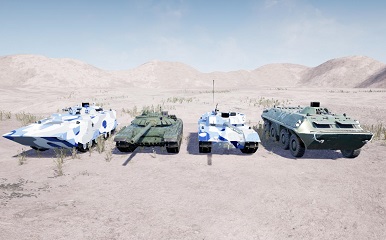XIAOZixun, LIUHaoran, CHENTairan, HUANGBiao, WANGGuoyu
Acta Armamentarii. 2025, 46(9):
240809.
The water-jet propeller is main propulsion plant of amphibious vehicle when it navigates on the surface.There are significant differences in the vehicle body attitude and the inflow conditions of propeller at different navigation depths in the land-water interface zone,which significantly affects the propulsion performance.In order to study the mutual influence of amphibious vehicle and water-jet propeller under water depth conditions,this paper takes water jet propulsion amphibious vehicle as the research object,and uses the finite volume method,the shear stress transport (SST) turbulence model,the volume of fluid (VOF) two-phase flow model and the dynamic fluid body interaction (DFBI) motion model to numerically calculate the hydrodynamic performance of the pump-vehicle-integrated amphibious vehicle at different rotational speeds of water-jet propeller under different water depth conditions.The grid uncertainty is analyzed,and the accuracy of the algorithm is verified by comparing the calculated values with the experimental results.The motion law,flow field distribution characteristics and hydrodynamic performance of the pump-vehicle-integrated amphibious vehicle under different navigation conditions were obtained through analysis.The results show that,in the deep water environment,the amphibious vehicle is in the drainage sailing state,and the body attitude of vehicle changes greatly when sailing at a low speed,which affects the stability of the axial flow of fluid in the propeller; the body sailing state of vehicle and the flow rate and head of propeller are relatively stable when sailing at a high speed.In shallow water environment,the amphibious vehicle is in subcritical state when sailing in low speed and has larger longitudinal inclination and sinking amount than those in deep water environment,and the resistance of the vehicle body is increased by 13.65% on average.When sailing at high speed,the amphibious vehicle enters into the supercritical state,the vehicle body floats up rapidly,and the sailing speed is the same as that under the deep water condition.And after the stabilisation,the amplitude of attitude change is small,and the stability of propeller performance is improved.In the shallow water environment with different depths,the vehicle body in the shallower water environment is more obviously affected by the shallow water effect and is subjected to greater resistance during low-speed navigation,while there is no obvious difference in the hydrodynamic performance of amphibious vehicle at different depths during high-speed navigation.Therefore,the amphibious vehicle should increase the output power of the propeller when passing through the shallow water area and quickly enters the supercritical state to reduce the influence of shallow water effect on it.




